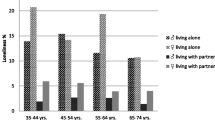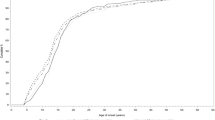Abstract
Purpose
To analyze the distribution of depressive, anxiety, and somatization symptoms across different occupational positions in a random sample of Danish residents.
Methods
The study sample consisted of 591 Danish residents (50% women), aged 20–65, drawn from an age- and gender-stratified random sample of the Danish population. Participants filled out a survey that included the 92 item version of the Hopkins Symptom Checklist (SCL-92). We categorized occupational position into seven groups: high- and low-grade non-manual workers, skilled and unskilled manual workers, high- and low-grade self-employed, and unemployed.
Results
Compared to the reference group of high-grade non-manual workers, the depressive symptom score was statistically significantly elevated among unskilled manual workers (P = 0.043) and the unemployed (P < 0.001), after adjustment for age, gender, cohabitation, life events, and low household income. The anxiety symptom score was elevated only among the unemployed (P = 0.004). The somatization symptom score was elevated among unskilled manual workers (P = 0.002), the low-grade self-employed (P = 0.023), and the unemployed (P = 0.001). When we analyzed caseness of severe symptoms, we found that unskilled manual workers (OR = 3.27, 95% CI = 1.06–10.04) and the unemployed (OR = 6.20, 95% CI = 1.98–19.42) had a higher prevalence of severe depressive symptoms, compared to the reference group of high-grade non-manual workers. The unemployed also had a higher prevalence of severe somatization symptoms (OR = 6.28, 95% CI = 1.39–28.46).
Conclusions
Unskilled manual workers, the unemployed, and, to a lesser extent, the low-grade self-employed showed an increased level of mental distress. Activities to promote mental health in the Danish population should be directed toward these groups.
Similar content being viewed by others
References
Bonde J (2008) Psychosocial factors at work and risk of depression: a systematic review of the epidemiological evidence. Occup Environ Med 65(7):438–445
Bültmann U, Rugulies R, Lund T, Christensen KB, Labriola M, Burr H (2006) Depressive symptoms and the risk of long-term sickness absence: a prospective study among 4747 employees in Denmark. Soc Psychiatry Psychiatr Epidemiol 41(11):875–880
Bültmann U, Christensen KB, Burr H, Lund T, Rugulies R (2008) Severe depressive symptoms as predictor of disability pension: a 10-year follow-up study in Denmark. Eur J Public Health 18(3):232–234
Derogatis TS (1994) SCL-90-R: symptom checklist-90-R. Administration, scoring and procedures manual, 3rd edn. National Computer Systems, Minneapolis
Macleod J, Davey Smith G (2003) Psychosocial factors and public health: a suitable case for treatment? J Epidemiol Community Health 57(8):565–570
Melchior M, Krieger N, Kawachi I, Berkman LF, Niedhammer I, Goldberg M (2005) Work factors and occupational class disparities in sickness absence: findings from the GAZEL cohort study. Am J Public Health 95(7):1206–1212
Montgomery SM, Cook DG, Bartley MJ, Wadsworth ME (1999) Unemployment pre-dates symptoms of depression and anxiety resulting in medical consultation in young men. Int J Epidemiol 28(1):95–100
Netterstrøm B, Conrad N, Bech P, Fink P, Olsen O, Rugulies R et al (2008) The relation between work-related psychosocial factors and the development of depression. Epidemiol Rev 30(1):118–132
Olsen LR, Mortensen EL, Bech P (2004) The SCL-90 and SCL-90R versions validated by item response models in a Danish community sample. Acta Psychiatr Scand 110(3):225–229
Olsen LR, Mortensen EL, Bech P (2006) Mental distress in the Danish general population. Acta Psychiatr Scand 113(6):477–484
Stansfeld SA, Head J, Fuhrer R, Wardle J, Cattell V (2003) Social inequalities in depressive symptoms and physical functioning in the Whitehall II study: exploring a common cause explanation. J Epidemiol Community Health 57(5):361–367
Thielen K, Nygaard E, Andersen I, Rugulies R, Heinesen E, Bech P et al (2009) Misclassification and the use of register-based indicators for depression. Acta Psychiatr Scand 119(4):312–319
Wittchen HU, Jacobi F (2005) Size and burden of mental disorders in Europe—a critical review and appraisal of 27 studies. Eur Neuropsychopharmacol 15(4):357–376
Acknowledgments
The analyses of this study were partly funded by a grant of the Danish Work Environment Research Fund (Grant Number: 5-2006-04).
Conflict of interest
The authors declare that they have no conflict of interest.
Author information
Authors and Affiliations
Corresponding author
Rights and permissions
About this article
Cite this article
Rugulies, R., Madsen, I.E.H., Nielsen, M.B.D. et al. Occupational position and its relation to mental distress in a random sample of Danish residents. Int Arch Occup Environ Health 83, 625–629 (2010). https://doi.org/10.1007/s00420-009-0492-8
Received:
Accepted:
Published:
Issue Date:
DOI: https://doi.org/10.1007/s00420-009-0492-8




